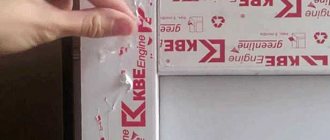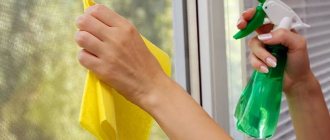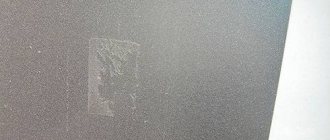What is the cause of yellowness
Housewives often take excellent care of their windows: they regularly wash the window sills and frames, and polish the glass until it shines. But the plastic still turns yellow. The cause of the problem most likely lies in the poor quality material from which the structures are made. Unscrupulous manufacturers use polymers that can deteriorate over time.
High-quality materials contain specialized stabilizers that protect plastic from exposure to sunlight. Due to this, the structures remain snow-white for a long time, and with proper care they practically do not darken or turn yellow.
Kitchen windows are often the ones that get damaged. This is due to the impact of temperature changes on the surface of the frames, the adhesion of fat and soot. It is not difficult to wash plastic from dirt and grease; it is only important to use gentle compounds, without abrasive particles.
If the housewife cleans plastic structures with a hard brush, powder, using acetone or other solvents, the surface layer of the frame is damaged and scratches appear. This inevitably leads to darkening of the plastic and its deterioration.
Why do plastic windows turn yellow?
Unfortunately, the snow-white appearance of plastic windows does not last forever. Soon after installation, you will notice that the color of the plastic takes on a yellow tint. There could be many reasons for this:
- The color may change if you have a low quality window installed. Perhaps the technology was violated during the production of the profile. The plastic from which PVC windows are made includes many components that are responsible for durability and color preservation. One such substance is titanium dioxide, which gives plastic its white color. In addition, PVC contains special stabilizers. They are needed to protect the profile from exposure to ultraviolet radiation. It is thanks to these stabilizers that the plastic does not turn yellow and does not fade under sunlight. If you use low-quality raw materials to make a window, then after 3-4 years the plastic window sill and frames will begin to change their color.
- Adverse weather conditions also negatively affect the color and integrity of plastic windows. Due to a sharp change in temperature, the properties of the polymer may change. As a result, it may not only turn yellow, but also crack. This usually happens with cheap windows made from low quality raw materials.
- Most often, windows installed in the kitchen are subject to color changes. Soot from burnt food settles on them. Since there is a hood in the kitchen, very often a smoking area is set up there. Then cigarette smoke also settles on the plastic. These stains can be cleaned and can be removed with a regular soap solution.
- If PVC windows are not properly cared for, they may change color. Under no circumstances should you clean plastic with strong abrasives or substances containing acid or caustic alkali. Their use may damage the surface, the gloss will disappear and the color of the plastic will turn yellow.
If your window has turned yellow due to the poor quality of the material, you will not be able to return it to its original whiteness, since the change has occurred at the molecular level. A high-quality window can last a very long time - up to 50 years. Therefore, you should not skimp on its installation. It is best to choose those manufacturers who have already won the trust of many buyers.
What products should not be used
There are products and tools that absolutely cannot be used when washing plastic frames. Among them:
- Hard metal brushes and sponges.
- Scrapers.
- Products containing abrasives are high-hardness cleaning powders.
- Solvents.
- Melamine sponge.
- Strong acids. Like solvents, they will corrode the surface and destroy the glossy finish of the frames.
Otherwise, there are no limits to perfection. You can use cheap improvised means that will preserve the whiteness of plastic structures for a long time.
How to care for plastic?
Caring for plastic windows involves regularly cleaning them from dirt, dust, and hand marks. This allows you to preserve the appearance of the material and protect it from external negative influences.
At the same time, there is no prevention against the appearance of a yellow tint of PVC. If the material is of poor quality and does not contain a sufficient amount of stabilizing additives, the appearance of yellowness is only a matter of time.
For routine care, mild detergents and special microfiber cloths are used. If difficult stains are detected, it is necessary to use a special composition from the category of household or professional chemical cleaning products. There are many of them in hardware stores. To perform deep cleaning of plastic, it is recommended to use products from the category of automotive chemicals.
What do manufacturers offer?
Factory products work well against yellowing on frames. It all depends on the source of this yellowness. If this is a kitchen window, stronger products such as “Mr. Muscle” and “Proper” are suitable. They contain alcohols. They perfectly dissolve yellow fatty deposits.
However, it is worth remembering that after using the products, you must thoroughly rinse off these compounds with water and wipe the frames dry.
In addition, you can use Domestos. It contains chlorine. It not only removes dirt, but also disinfects surfaces well. And in this case, the product will need to be thoroughly rinsed with water.
If you can't remove stains
It happens that some stain is too ingrained or old yellowness cannot be removed. In this case, you can save the window sill only by updating it a little.
We do not encourage you to do repairs at all. It is enough to purchase a white PVC film and carefully cover the window sill. The advantage of this method is that you can choose any color - even with a pattern. However, this does not mean that you need to stop washing the window sill and just re-stick the film from time to time.
A wide palette will allow you to update the window sill and refresh the interior. In addition, if you use our recommendations, then you will not need such drastic measures - the window sill will already look impeccable.
Traditional methods for combating yellowness on plastic frames
Experts recommend using ordinary soap or its liquid version when washing window structures. A small piece of soap must be grated or cut and poured with a glass of boiling water. Let it brew and stir. The composition must be applied to plastic frames, left for 30-40 minutes, then rub the yellow spots with a soft sponge. Next, rinse off the product with water.
It is important to remember that when working with even the most gentle compounds, you should use gloves and respiratory protection.
Toothpaste or powder
This product only fights fresh yellowness. If the stains are old, toothpaste will not help. So, you need to squeeze a little paste onto a soft sponge or flannel cloth, rub the stains, leave for an hour and then rinse thoroughly with water.
- You can use tooth powder. It does not contain large abrasive particles and whitens plastic perfectly.
- The powder must be mixed in equal proportions with crushed chalk and diluted with water to form a thick mass.
- Afterwards, you need to apply this composition to the yellow spots and leave for half an hour.
- During this time, the product will dry and can be easily removed. The powder will absorb the yellowness.
- If you fail to clean the frames the first time, you should reapply the product.
Soda
This is a universal remedy that fights grease stains, soot or even soot. Soda also has a bleaching effect and works great on yellowing that appears on plastic structures.
- Soda should be combined with other detergents.
- It enhances their effect in eradicating yellow spots on plastic.
- You need to dilute a little powder in warm water, add soda, stir, rinse the frames and window sill with this solution and do not wash off the composition for 24 hours.
- Afterwards wash and wipe dry.
Vinegar, citric acid
The action of these products is considered gentle; vinegar does not corrode plastic. Granular acid must be dissolved in water in a ratio of 1 part powder to 10 parts water.
Any of these products must be applied carefully, testing the effect on a small area of the plastic surface. At the end of the procedures for removing yellowness, frames and window sills must be rinsed with water and wiped dry.
Liquid bleach
You can use the powder version.
- Mix bleach powder with liquid citric acid or vinegar, add 50 ml of water, apply to stains, rinse after 40 minutes.
- This remedy works for sure. Bleach whitens surfaces and helps get rid of stains of any complexity.
Hydrogen peroxide
A three percent solution is needed. This liquid is sold without a prescription at any pharmacy.
- You need to soak a foam sponge in peroxide and rub it on plastic surfaces, including the window sill.
- Wait until the stains lighten and rinse off the composition with water.
- You can use hydrogen peroxide to clean plastic structures as often as you like. The product does not damage plastic.
From yellow plaque or fat
A competent choice of solution for cleaning plastic products from yellowness and greasy stains will make the procedure easier.
It must be remembered that to wash this material you cannot use powdered products, brushes, or scrapers, as they can damage the surface.
You can remove greasy stains using:
- Apply detergent to a soft cloth, wipe the desired area, leave for 10 minutes, and rinse.
- Melamine sponge. They wipe away yellow plaque or fat.
- Windshield wipers contain alcohol, which corrodes greasy areas
Alcohol-containing compounds
There is no need to use forty proof vodka. You will need medical ethyl alcohol. Of course, it is not advisable to dilute it with water, otherwise the temperature will decrease to the same vodka.
Such a remedy will have little effect. So, you need to apply a little alcohol to a cotton pad or foam sponge and wipe the plastic surfaces.
You can try ammonia. If it doesn't work, you should mix it with a small amount of hydrogen peroxide. This composition has excellent bleaching properties and does not corrode plastic.
Preparing for whitening
At the preparatory stage, it is important to prepare everything necessary for cleaning and put the surface to be cleaned in order.
Before you start washing, you need to get rid of all unnecessary and interfering elements.
First thing:
- remove the tulle from the window, remove flowers, car accessories (if you are cleaning a car dashboard) so that they do not interfere;
- prepare a cleaning product;
- stock up on rags and a soft sponge;
After this, we proceed to wet cleaning to get rid of debris contaminating work equipment.
Photo instructions on how to remove yellowness from plastic windows
Washing double glazed windows
Cleaning a double-glazed window from dirt is not so difficult. And using a professional tool from the arsenal of cleaning companies, you can handle it in a couple of minutes.
First, prepare a foam solution, for example, with dishwashing gel. Dip a non-abrasive sponge in it, squeeze out so that the water does not run off, and wipe the surface of the glass unit with horizontal movements. If you use store-bought household chemicals, apply the product to the glass with a spray bottle and also rub it with a sponge on the glass using horizontal movements. Pay special attention to the area along the glass unit where most of the dirt accumulates.
Precautionary measures
Most of the compounds used are highly aggressive. Therefore, the process requires ensuring maximum safety for the skin and mucous membranes. If substances come into contact with certain parts of the body, significant irritation or allergies may occur. During work, be sure to use protective rubber gloves, goggles and a respirator. Provide a constant supply of fresh air.
If the substance gets on the mucous membrane, rinse it with plenty of water. If necessary, consult a doctor.
If the yellowness on the plastic is not due to poor-quality material, then you can get rid of it in different ways. The effectiveness of each product will vary, but they can help with cleaning. Be sure to follow safety precautions when working. Otherwise, allergic reactions on the skin and mucous membranes are possible. There is no way to bleach plastic quickly. In most cases you will have to clean it several times.
Elimination of construction pollution
It's no secret that the installation of plastic windows is carried out almost at the initial stage of repair. Accordingly, during work, such a structure often gets dirty.
Of course, the window sill and the glass themselves are covered with a special film, but it does not always protect from dirt. In this case, you will have to resort to the following processing:
- It is necessary to remove the plugs from plastic windows so that dirt does not accumulate at the joints. After this, wipe the surface with a dry cloth. If there is a lot of dirt, sweep it away with a broom or remove it with a vacuum cleaner. Then the plastic window is wiped with a damp sponge. It is best to give preference to microfiber, fleece or flannel.
- If there are traces of plaster on the plastic window sill, then you need to apply a special product to them and leave it for 2-5 minutes so that the dirt is completely saturated.
- If it is remnants of polyurethane foam, you will have to cut it off if possible, and then apply a special solvent again, making sure that the substance does not get on the plastic. After 15 minutes, the foam will soften and can be removed with a rubber spatula. Also, the residues should be carefully scraped off with a hard-bristled brush.
- When rinsing off the detergent, you need to pry off the dirt with a rubber spatula.
- At the last stage, the remaining stains are washed off with water and the window sill is wiped dry.
When the plastic surface becomes clean again after the repair, you can carefully rub it with polish.
Care and prevention
You can prevent the appearance of yellowness on a plastic surface by observing the following measures:
- do not smoke indoors or near windows;
- Prevent exposure to direct sunlight by using curtains, blinds or kitchen cloths;
- use for processing only those products that are suitable for cleaning plastic;
- ventilate the room more often;
- Clean the surface from dirt immediately after it appears.
Several times a week, it is recommended to wipe household appliances or window sills with a sponge soaked in a mild soap solution to maintain a neat and tidy appearance.
Purchasing a product made of high-quality material and observing regular care and basic preventive measures for plastic contamination is the key to preventing the formation of yellowness. If plaque does appear, it should be immediately eliminated using folk or ready-made household remedies.
Various alcohols
Due to the fact that plastic does not react chemically with alcohol solutions (methanol, ethanol, isopropanol, etc.), they can be safely used to whiten yellowed stains. But to be sure of a successful outcome, it is better to check the reaction of a particular plastic surface to such a radical substance. To do this, walk (with rubber gloves!) over the most inconspicuous area with a cotton pad soaked in alcohol; if everything goes well, then you can safely wipe all the yellowed areas. There is no need to rinse off alcohol solutions, but the room must be ventilated.
Adviсe
Several recommendations will help make the process of washing balcony windows better and safer:
- First of all, wash the frames and glass located inside the balcony, then the outside of the window. This way, all contamination can be seen more clearly, and the work will not have to be redone.
- Glycerin will help keep balcony window glass clean longer. It is enough to rub the already washed glasses with a napkin soaked in a glycerin solution (1 tablespoon of pharmaceutical product is enough for 250 ml of water).
- Metal-plastic window frames cannot be cleaned with dry abrasives. Powders leave scratches on the surface of the plastic that cannot be removed.
- Do not wash plastic with very hot water. High temperatures may cause metal-plastic window frames to turn yellow.
- A saline solution will help protect balcony windows from icing in winter (2 tablespoons of salt per 250 ml of water is enough). You can also rub clean glass with a mixture of glycerin and alcohol (ratio 1:20).
When washing balcony windows (especially those located on high floors) from the outside, it would be a good idea to use a safety belt or enlist the support of another person.
You will find a lot of important and useful information about fast and effective window cleaning in this section.











